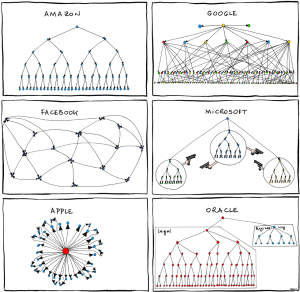Network structure - confirmation bias
I’ve recently read the book about Black Swan theory. If you are going to read comments about this book you will find it very controversial. But i would recommend to read it anyway as it suggest slightly different view on complexity and our desire to rationalize everything (especially when it’s already happened).
I want to share notes from the book about the _complexity_ and how it maps to POD framework (or any other network organisation) we are starting to apply in a company.
Even though it might look like a confirmation bias why network structure is much better than hierarchical structure. But f*** it, i treat it as thinking tool and mental exercise.
When organisation grows bigger the complexity increases and as the result more risks become hidden and one of the main ideas is to bring them on the surface.
Definition of Complexity from the book:
What is a complex system? It’s a system where elements are strongly related in time (element depends on its own historical transformations), horizontally (elements are mutually dependent) and in diagonal (A depends on a history of B)
For me it’s a perfect definition of a product development team that works on a complex solution with many offerings. So here are some suggestions on how to manage risks (or make them visible).
Time
Book: Management shouldn’t get bonuses based on short-term targets (1 year). All decisions must be evaluated from a long-term perspective.
Network structure: when you organize yourself around value creation you must think in a long-term perspective because you need to evaluate following things: who will use it? is it a big group? do they really need that? when do they need that? who are competitors? and etc.
Avoid optimization
Book: It leads to narrow specialization and system becomes too much dependant on exact planning and you cannot predict/foresee all options. It leads to more hidden risks within the system.
Network structure: each cell in a network structure has the authority and right level of autonomy to solve problems in their own way to avoid centralization when it’s not needed.
Prediction of distant events
Book: It’s impossible to predict distant events (and their impact) in a complex system. Most predictions are based on historical failures, but it doesn’t explain the nature of next one as we don’t know all inputs and dependency (planning tends to simplify things).
Network structure: i don’t like planning. i believe that right level of transparency instead of strategic planning solves the problem much better. Better to have right information at any moment in the future in order to make right decisions than try to predict decisions based on information you have now.
Weak things
Book: Weak things must break while they are small as it reduces the impact of the event.
Network structure: cells are created around value and it must be “closed” if it doesn’t prove it works otherwise it must split as outgrows certain size or tries to solve very diverse set of problems, which results in a huge loss of focus, slow value delivery, possible queues and etc.
That’s it.
p.s. If interested you can read a bit more about the theory and the author please visit Wikipedia.
Black Swan Theory - http://en.wikipedia.org/wiki/Black_swan_theory
Nassim Nicholas Taleb - http://en.wikipedia.org/wiki/Nassim_Nicholas_Taleb
 Previous post (
Previous post (